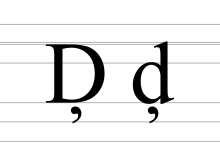D-comma: Difference between revisions
m Bot: fixing section wikilinks |
Ferclopedio (talk | contribs) image |
||
| (32 intermediate revisions by 22 users not shown) | |||
| Line 1: | Line 1: | ||
{{short description|Letter of the Latin alphabet}} |
|||
| ⚫ | |||
{{Redirect-distinguish|D̦|Ḑ}} |
|||
| ⚫ | ''' |
||
| ⚫ | |||
| ⚫ | '''D-comma''' (majuscule: '''D̦''', minuscule: '''d̦''') is a letter that was part of the [[Romanian alphabet]] to represent the sound {{IPA|/z/}} or {{IPA|/dz/}} if it was derived from a [[Latin language|Latin]] ''d'' (e.g. {{lang|ro|d̦i}}, pronounced {{IPA|/zi/}} came from Latin {{lang|la|die}}, day).<ref>Negruzzi, p. 234.</ref> It was the equivalent of the [[Cyrillic script|Cyrillic]] letters [[Ze (Cyrillic)|З]] and [[Dze|Ѕ]]. |
||
| ⚫ | |||
| ⚫ | This letter was first introduced by [[Petru Maior]] in his 1819 book {{lang|la|Ortographia romana sive Latino–Valachica, una cum clavis, qua penetralia originationis vocum reserantur...}}: "{{lang|la|'''d̦''' sicut Latinorum '''[[z]]''' ac cyrillicum '''[[Ze (Cyrillic)|з]]'''}}".<ref>Vîrtosu, p. 208</ref> |
||
In 1844 [[Ioan Eliade]] introduced ''{{unicode|d̦}}'' again in his magazine ''Curierul de ambe sexe'' as a substitute for ''з''<ref>Vîrtosu, p. 223.</ref>. |
|||
In 1844, [[Ioan Eliade]] introduced ''d̦'' again, in his magazine {{lang|ro|Curierul de ambe sexe}}, as a substitute for ''[[Ze (Cyrillic)|з]]''.<ref>Vîrtosu, p. 223.</ref> |
|||
On 23 October 1858, the {{lang|ro|Eforia Instrucțiunii Publice}} of [[Wallachia]] issued a decree in which, among other rules, ''d̦'' was for the third time adopted instead of Cyrillic ''[[Ze (Cyrillic)|з]]''. However, the rule would not be fully adopted until later.<ref>Vîrtosu, p. 234–235.</ref> |
|||
| ⚫ | |||
| ⚫ | |||
| ⚫ | In [[Moldavia]], the transitional alphabet and the letter '' |
||
| ⚫ | In [[Moldavia]], the transitional alphabet and the letter ''d̦'' was adopted much later. In his grammar, published in [[Paris]] in 1865, [[Vasile Alecsandri]] adopted this sign instead of ''[[Ze (Cyrillic)|з]]'', viewing the comma below ''[[d]]'' as a small ''[[s]]'' (''d̦'' was often pronounced {{IPA|/dz/}}, {{IPA|/ds/}}. This was also the case with [[s-comma|ș]]—''ss'' and [[t-comma|ț]]—''ts'').<ref>Vîrtosu, p. 245.</ref> |
||
This letter was abandoned in 1904 and is no longer in use. |
This letter was abandoned in 1904 and is no longer in use. |
||
This letter is part of the [[Livonian language#Alphabet|Livonian alphabet]] but is presented with [[Ḑ|D-cedilla]] in practice. |
|||
==Computer encoding== |
==Computer encoding== |
||
[[Unicode]] does not include [[precomposed character]]s for |
[[Unicode]] does not include [[precomposed character]]s for D̦ d̦—they must be represented with a [[combining diacritic]], which may not align properly in some [[typeface|fonts]]. Nevertheless, the sequence of base character + combining diacritic is given a unique name. Otherwise, the [[ḑ|D-cedilla]] (Ḑ ḑ) is somewhat to be a substitute as part of the Unicode standards because the visual appearance of D-cedilla is identical to D-comma as of the Unicode Consortium code chart for [[Latin Extended Additional]]. |
||
==See also== |
==See also== |
||
| Line 27: | Line 30: | ||
== References == |
== References == |
||
* Negruzzi, Constantin, |
* Negruzzi, Constantin, {{lang|ro|Studii asupra limbei române}}, in vol. "{{lang|ro|Alexandru Lăpuşneanul}}", {{lang|ro|Ed. Pentru Literatură}}, Bucharest, 1969. |
||
* Vîrtosu, Emil, |
* Vîrtosu, Emil, {{lang|ro|Paleografia româno-chirilică, Ed. Ştiinţifică}}, Bucharest, 1968. |
||
| ⚫ | |||
| ⚫ | |||
[[Category:Specific letter-diacritic combinations|D-comma]] |
|||
{{Romanian language}} |
|||
[[Category:Latin letters with diacritics]] |
|||
[[fr:D̦]] |
|||
[[Category:Romanian language]] |
|||
[[Category:1819 introductions]] |
|||
Revision as of 23:26, 19 May 2024

D-comma (majuscule: D̦, minuscule: d̦) is a letter that was part of the Romanian alphabet to represent the sound /z/ or /dz/ if it was derived from a Latin d (e.g. d̦i, pronounced /zi/ came from Latin die, day).[1] It was the equivalent of the Cyrillic letters З and Ѕ.
This letter was first introduced by Petru Maior in his 1819 book Ortographia romana sive Latino–Valachica, una cum clavis, qua penetralia originationis vocum reserantur...: "d̦ sicut Latinorum z ac cyrillicum з".[2]
In 1844, Ioan Eliade introduced d̦ again, in his magazine Curierul de ambe sexe, as a substitute for з.[3]
On 23 October 1858, the Eforia Instrucțiunii Publice of Wallachia issued a decree in which, among other rules, d̦ was for the third time adopted instead of Cyrillic з. However, the rule would not be fully adopted until later.[4]
Taking the matter in his hands, internal affairs minister Ion Ghica stated on 8 February 1860 that whoever in his order ignored the new transitional alphabet would be fired.[5]
In Moldavia, the transitional alphabet and the letter d̦ was adopted much later. In his grammar, published in Paris in 1865, Vasile Alecsandri adopted this sign instead of з, viewing the comma below d as a small s (d̦ was often pronounced /dz/, /ds/. This was also the case with ș—ss and ț—ts).[6]
This letter was abandoned in 1904 and is no longer in use.
This letter is part of the Livonian alphabet but is presented with D-cedilla in practice.
Computer encoding
Unicode does not include precomposed characters for D̦ d̦—they must be represented with a combining diacritic, which may not align properly in some fonts. Nevertheless, the sequence of base character + combining diacritic is given a unique name. Otherwise, the D-cedilla (Ḑ ḑ) is somewhat to be a substitute as part of the Unicode standards because the visual appearance of D-cedilla is identical to D-comma as of the Unicode Consortium code chart for Latin Extended Additional.
See also
Notes
References
- Negruzzi, Constantin, Studii asupra limbei române, in vol. "Alexandru Lăpuşneanul", Ed. Pentru Literatură, Bucharest, 1969.
- Vîrtosu, Emil, Paleografia româno-chirilică, Ed. Ştiinţifică, Bucharest, 1968.
